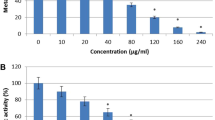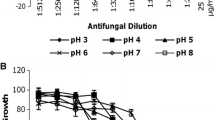Abstract
The present study was undertaken to evaluate and characterize the phytase activity in different Candida species. A total of 113 Candida isolates representing eight species were examined for phytase activity by an agar plate assay using the calcium salt of phytic acid as the sole phosphorus source. A phytase-positive phenotype was identified by the formation of a clear halo around a fungal colony. Cell-bound differential phytase activity was observed in Candida isolates at inter- and intra-species levels. Although phytase activity was not affected by the supplementation of external phosphate in C. albicans, C. dubliniensis, C. glabrata, and C. kefyr, elevated phytase activity was evident in C. guilliermondii, C. krusei, C. parapsilosis, and C. tropicalis in phosphate-free medium. Further characterization showed that, in general, relatively higher phytase activity was observed at more acidic pHs, and the phytase activity increased with incubation temperature, reaching a maximum at 55 or 65°C. Taken together, the findings demonstrated, for the first time, differential phytase activities in different Candida species. Phytase activity may be a contributing factor to fungal survival and proliferation within the human gastrointestinal tract, where nutrients are usually scarce.
Similar content being viewed by others
References
Krcmery V, Barnes AJ. Non-albicans Candida spp. causing fungaemia: pathogenicity and antifungal resistance. J Hosp Infect. 2002;50:243–60.
Cheng MF, Yu KW, Tang RB, Fan YH, Yang YL, Hsieh KS, et al. Distribution and antifungal susceptibility of Candida species causing candidemia from 1996 to 1999. Diagn Microbiol Infect Dis. 2004;48:33–7.
Kang K, Wong KS, Seneviratne CJ, Samaranayake LP, Fong WP, Tsang PWK. In vitro synergistic effects of metergoline and antifungal agents against Candida krusei. Mycoses. 2010;53:495–9.
Odds FC. Candida species and virulence. ASM News. 1994;60:313–8.
Corner BE, Magee PT. Candida pathogenicity: unraveling the threads of infection. Curr Biol. 1997;7:R691–4.
Soll DR. Why does Candida albicans switch? FEMS Yeast Res. 2009;9:973–89.
Alby K, Bennett RJ. To switch or not switch? Phenotypic switching is sensitive to multiple inputs in a pathogenic fungus. Commun Integr Biol. 2009;2:509–11.
Pukkila-Worley R, Peleg AY, Tampakakis E, Mylonakis E. Candida albicans hyphal formation and virulence assessed using a Caenorhabditis elegans infection model. Eukaryot Cell. 2009;8:1750–8.
Kumamoto CA, Vinces MD. Contributions of hyphae and hypha-co-regulated genes to Candida albicans virulence. Cell Microbiol. 2005;7:1546–54.
Tronchin G, Pihet M, Lopes-Bezerra LM, Bouchara JP. Adherence mechanisms in human pathogenic fungi. Med Mycol. 2008;46:749–72.
Biasoli MS, Tosello ME, Luque AG, Magaró HM. Adherence, colonization and dissemination of Candida dubliniensis and other Candida species. Med Mycol. 2010;48:291–7.
Schaller M, Borelli C, Korting HC, Hube B. Hydrolytic enzymes as virulence factors of Candida albicans. Mycoses. 2005;48:365–77.
Bramono K, Yamazaki M, Tsuboi R, Ogawa H. Comparison of proteinase, lipase and alpha-glucosidase activities from the clinical isolates of Candida species. Jpn J Infect Dis. 2006;59:73–6.
Ma L, Xie L, Dong X, Shi W. Role of extracellular phospholipase B of Candida albicans as a virulent factor in experimental keratomycosis. Curr Eye Res. 2009;34:761–8.
Gokce G, Cerikcioglu N, Yagci A. Acid proteinase, phospholipase, and biofilm production of Candida species isolated from blood cultures. Mycopathologia. 2007;164:265–9.
Trinel PA, Plancke Y, Gerold P, Jouault T, Delplace F, Schwarz RT, et al. The Candida albicans phospholipomannan is a family of glycolipids presenting phosphoinositolmannosides with long linear chains of β-1,2-linked mannose residues. J Biol Chem. 1999;274:30520–6.
Reynolds TB. Strategies for acquiring the phospholipid metabolite inositol in pathogenic bacteria, fungi and protozoa: making it and taking it. Microbiology. 2009;155:1386–96.
Lei XG, Porres JM. Phytase enzymology, applications, and biotechnology. Biotechnol Lett. 2003;25:1787–94.
Afinah S, Yazid AM, Anis Shobirin MH, Shuhaimi M. Phytase: application in food industry. Int Food Res J. 2010;17:13–21.
Konietzny U, Greiner R. Molecular and catalytic properties of phytate-degrading enzymes (phytases). Int J Food Sci Technol. 2002;37:791–812.
Rao DECS, Rao KV, Reddy TP, Reddy VD. Molecular characterization, physicochemical properties, known and potential applications of phytases: an overview. Crit Rev Biotechnol. 2009;29:182–98.
Lambrechts C, Boze H, Moulin G, Galzy P. Utilization of phytate by some yeasts. Biotechnol Lett. 1992;14:61–6.
Nakamura Y, Fukuhara H, Sano K. Secreted yeast activities of yeasts. Biosci Biotechnol Biochem. 2000;64:841–4.
DeAngelis M, Gallo G, Corbo MR, McSweeney PL, Faccia M, Giovine M, et al. Phytase activity in sourdough lactic acid bacteria: purification and characterization of a phytase from Lactobacillus sanfranciscensis CB1. Int J Food Microbiol. 2003;87:259–70.
Haros M, Bielecka M, Honke J, Sanz Y. Myo-inositol hexakisphosphate degradation by Bifidobacterium infantis ATCC 15697. Int J Food Microbiol. 2007;117:76–84.
Olstorpe M, Schnürer J, Passoth V. Screening of yeast strains for phytase activity. FEMS Yeast Res. 2009;9:478–88.
Hellström AM, Vázques-Juárez R, Svanberg U, Andlid TA. Biodiversity and phytase capacity of yeasts isolated from Tanzanian togwa. Int J Food Microbiol. 2010;136:352–8.
Quan CS, Fan SD, Zhang LH, Wang YJ, Ohta Y. Purification and properties of a phytase from Candida krusei WZ-001. J Biosci Bioeng. 2002;94:419–25.
MacCallum DM, Castillo L, Nather K, Munro CA, Brown AJ, Gow NA, et al. Property differences among the four major Candida albicans strain clades. Eukaryot Cell. 2009;8:373–87.
Haros M, Bielecka M, Sanz Y. Phytase activity as a novel metabolic feature in Bifidobacterium. FEMS Microbiol Lett. 2005;247:231–9.
Bradford MM. A rapid and sensitive method for the quantitation of microgram quantities of protein utilizing the principle of protein-dye binding. Anal Biochem. 1976;72:248–54.
Anil S, Samaranayake LP. Brief exposure to antimycotics reduces the extracellular phospholipase activity of Candida albicans and Candida tropicalis. Chemotherapy. 2003;49:243–7.
Kadir T, Gümrü B, Uygun-Can B. Phospholipase activity of Candida albicans isolates from patients with denture stomatitis: the influence of chlorhexidine gluconate on phospholipase production. Arch Oral Biol. 2007;52:691–6.
Galán-Ladero MA, Blanco MT, Sacristán B, Fernández-Calderón MC, Pérez-Giraldo C, Gómez-García AC. Enzymatic activities of Candida tropicalis isolated from hospitalized patients. Med Mycol. 2010;48:207–10.
Luo G, Samaranayake LP, Yau JYY. Candida species exhibit differential in vitro hemolytic activities. J Clin Microbiol. 2001;39:2971–4.
Rodrigues AG, Pina-Vaz C, Costa-de-Oliveira S, Tavares C. Expression of plasma coagulase among pathogenic Candida species. J Clin Microbiol. 2003;41:5792–3.
Bethea EK, Carver BJ, Montedonico AE, Reynolds TB. The inositol regulon controls viability in Candida glabrata. Microbiology. 2010;156:452–62.
Chen YL, Kauffman S, Reynolds TB. Candida albicans uses multiple mechanisms to acquire the essential metabolite inositol during infection. Infect Immun. 2008;76:2793–801.
Mukesh P, Suma S, Singaracharya MA, Lakshmipathi V. Isolation of phytate hydrolyzing microbial strains from traditional waste water of rice fermentation and liquid cattle feeds. World J Microbiol Biotechnol. 2004;20:531–4.
Tseng YH, Fang TJ, Tseng SM. Isolation and characterization of novel phytase from Penicillium simplicissimum. Folia Microbiol (Praha). 1994;45:121–7.
Lamping E, Ranchod A, Nakamura K, Tyndall JD, Niimi K, Holmes AR, et al. Abc1p is a multidrug efflux transporter that tips the balance in favor of innate azole resistance in Candida krusei. Antimicrob Agents Chermother. 2009;53:354–69.
Odds FC, Hierholzer JC. Purification and properties of a glycoprotein acid phosphatase from Candida albicans. J Bacteriol. 1973;114:257–66.
Li X, Liu Z, Chi Z, Li J, Wang X. Molecular cloning, characterization, and expression of the phytase gene from marine yeast Kodamaea ohmeri BG3. Mycol Res. 2009;113:24–32.
Acknowledgments
The research was supported by the Seed Funding Programme for Basic Research from the University of Hong Kong (Project No. 201003159008). The author thanks Prof. L. P. Samaranayake (The University of Hong Kong) for providing some of the Candida strains, Dr. Trevor Lane for editorial assistance, and Mrs. P. W. Y. Ho for helpful discussion.
Author information
Authors and Affiliations
Corresponding author
Rights and permissions
About this article
Cite this article
Tsang, P.WK. Differential Phytate Utilization in Candida species. Mycopathologia 172, 473–479 (2011). https://doi.org/10.1007/s11046-011-9453-3
Received:
Accepted:
Published:
Issue Date:
DOI: https://doi.org/10.1007/s11046-011-9453-3




